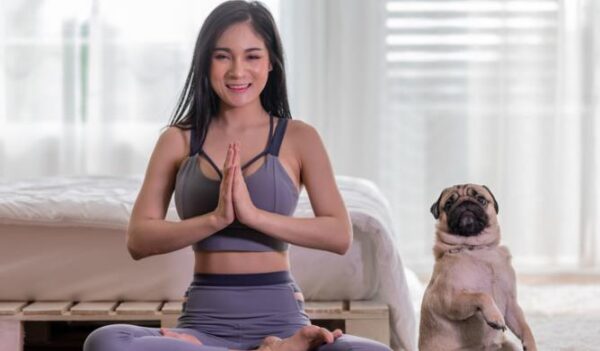Have you ever wondered how to combine the peacefulness of yoga with the playfulness of puppies? Well, the answer is puppy yoga! But what exactly is puppy yoga, and what are the benefits of incorporating these adorable creatures into your yoga practice? Let’s explore the world of puppy yoga and see how it can bring a whole new level of joy and wellness to your life.
Puppy yoga, also known as dog yoga or “doga,” is a unique and adorable twist on traditional yoga practices. In puppy yoga classes, participants engage in yoga poses and stretches while surrounded by playful and adorable puppies. These furry companions roam around the yoga studio, providing cuddles, kisses, and a sense of joy and relaxation to participants. Puppy yoga combines the physical benefits of yoga with the emotional benefits of spending time with animals, creating a fun and uplifting experience for both body and soul.
What to Expect in a Puppy Yoga Class?
When attending a puppy yoga class, it’s important to arrive a few minutes early to get acclimated to the environment and meet some of the puppies before the class starts. Participants should wear comfortable clothing that they don’t mind getting dirty or potentially scratched by playful puppies.
Proper animal handling is crucial to ensure the safety and well-being of both participants and puppies. Participants should approach puppies calmly and avoid forcing them into poses or uncomfortable positions. It’s important to be aware of one’s surroundings and the puppies’ safety throughout the class.
Participants should also use soothing tones and keep noise levels low to provide a calm and enjoyable experience for the puppies. Most importantly, participants should embrace the experience, have fun, and enjoy the playful energy that the puppies bring to the yoga session.
Why is there a rise in the popularity of puppy yoga?
Puppy yoga is becoming increasingly popular for several reasons. Firstly, it’s a fantastic stress reliever! Who wouldn’t feel better after a yoga session surrounded by playful puppies? Their playful nature and cute antics can instantly lift your spirits and relieve stress and anxiety. Secondly, puppy yoga offers a unique twist to your regular yoga routine, making it more fun and engaging.
It’s not just about the yoga poses; it’s also about connecting with these adorable furry friends. Thirdly, puppy yoga provides a great opportunity for socialization, both for humans and puppies. It’s a safe and controlled environment for puppies to interact with others and for humans to bond over their love for animals. Overall, puppy yoga is a delightful experience that combines the physical benefits of yoga with the joy of being around puppies, making it a popular choice for those looking for a fun and relaxing activity.
Benefits of Puppy Yoga

Participating in puppy yoga classes offers numerous benefits for both participants and puppies. Firstly, the presence of the puppies serves as a great motivator to consistently practice yoga and enjoy its long-term benefits.
Puppy yoga also improves mental health by boosting attention, focus, and concentration, reducing stress, and promoting positive feelings and socialization.
Additionally, puppy yoga classes can contribute to overall health improvement by lowering blood pressure, curbing appetite and stress eating, and encouraging weight loss.
Moreover, puppies in the classes also benefit from positive interactions and mental stimulation, improving their health and well-being. It is a mutually beneficial experience for both humans and puppies.
| Benefits of Puppy Yoga |
|---|
| Improves mental health |
| Boosts attention, focus, and concentration |
| Reduces stress |
| Promotes positive feelings and socialization |
| Contributes to overall health improvement |
| Lowers blood pressure |
| Curbs appetite and stress eating |
| Encourages weight loss |
| Provides positive interactions and mental stimulation for puppies |
| Improves health and well-being for puppies |
Dog Welfare and Ethical Concerns

While puppy yoga brings joy and happiness, there are genuine concerns regarding the welfare and ethical treatment of the participating puppies. Some puppy yoga classes involve puppies as young as six weeks old, which is against the law as they should be with their mothers until at least eight weeks old. There have been reports of puppies being forced to work for extended periods, denied access to water and rest, and subjected to potentially harmful environments.
The introduction of young puppies to a room full of strangers in an unfamiliar setting can be overwhelming and may have long-term negative effects on their emotional state and behavioral development. Additionally, the commodification of animals for profit and entertainment raises questions about our societal values and priorities. It is essential to consider the well-being and welfare of animals involved in puppy yoga and advocate for their rights and dignity.
Responsible practices and increased legislation are necessary to ensure the well-being and safety of animals in puppy yoga classes. Dog welfare should be a priority, guaranteeing that animals are not exploited for profit or entertainment. It is crucial to promote ethical treatment, responsible pet ownership, and the protection of all living beings, including our furry friends.
Is Puppy Yoga Good for Puppies, too?
Puppy yoga can be beneficial for puppies, as it can help with socialization, exposure to new experiences, and gentle physical activity. However, it’s important to ensure that the puppies are not put under any stress or discomfort during the yoga session. The focus should be on positive interactions and gentle movements that are suitable for their age and developmental stage. As with any activity involving animals, it’s recommended to consult with a veterinarian to ensure that puppy yoga is safe and appropriate for your puppy.
Puppy Yoga Poses
- Puppy Pose (Uttana Shishosana): This pose is great for stretching the spine, shoulders, and hips. To do this pose, start on your hands and knees in a tabletop position. Walk your hands forward a few inches and then lower your chest towards the ground, keeping your hips high. Your forehead can rest on the mat. This pose is gentle and relaxing, helping to calm the mind and relieve stress.
- Downward Dog Pose (Adho Mukha Svanasana): This is a well-known yoga pose that stretches the whole body. Start on your hands and knees, then lift your hips up and back, straightening your arms and legs so your body forms an upside-down V shape. Press your hands and feet into the ground and lengthen your spine. This pose strengthens the arms and legs, stretches the back and shoulders, and can help relieve tension in the body.
- Upward Dog Pose (Urdhva Mukha Svanasana): This pose is a gentle backbend that strengthens the spine and stretches the chest, shoulders, and abdomen. Start lying on your stomach with your hands by your sides, palms facing down. Press into your hands and lift your chest off the ground, keeping your legs and pelvis grounded. Your arms can be straight or slightly bent. This pose opens up the front of the body and can help improve posture.
- Seated Twist Pose: This pose is great for improving spinal mobility and digestion. Sit on the ground with your legs extended in front of you. Bend your right knee and place your right foot on the outside of your left knee. Place your left elbow on the outside of your right knee and twist gently to the right, looking over your right shoulder. Hold the pose for a few breaths, then repeat on the other side. Twists can help detoxify the body and improve digestion.
- Seated Forward Bend (Paschimottanasana): This pose is a calming stretch for the back, hamstrings, and spine. Sit on the ground with your legs extended in front of you. Inhale and lengthen your spine, then exhale and bend forward from the hips, reaching towards your feet or the floor. Keep your back straight and avoid rounding your spine. This pose can help relieve stress and anxiety, and it’s a good way to gently stretch the back of the body.
To Sum Up
The practice of puppy yoga offers a truly unique and delightful experience, combining the physical and mental benefits of yoga with the joy of being surrounded by adorable puppies. However, it is important to address the ethical concerns and welfare issues that come with this popular trend. Responsible pet ownership should always be a top priority, ensuring the well-being of animals and promoting their rights.
By supporting initiatives that promote proper care and treatment of animals, we can make a significant impact on their lives. It is crucial to question our own behaviors and attitudes towards animals, ensuring that they are not exploited for profit or entertainment. Advocating for responsible pet ownership and the welfare of animals plays a vital role in creating a society that values and protects the well-being of all living creatures.
Overall, puppy yoga can be a wonderful and enjoyable experience, but it is essential to practice it in a responsible and ethical manner. By treating animals with care and respect, we can ensure that puppy yoga remains a positive and beneficial activity for both participants and the adorable puppies who bring so much joy to our practice. Together, let’s embrace responsible pet ownership and create a world where animals are cherished and protected.
Recommended Articles:

